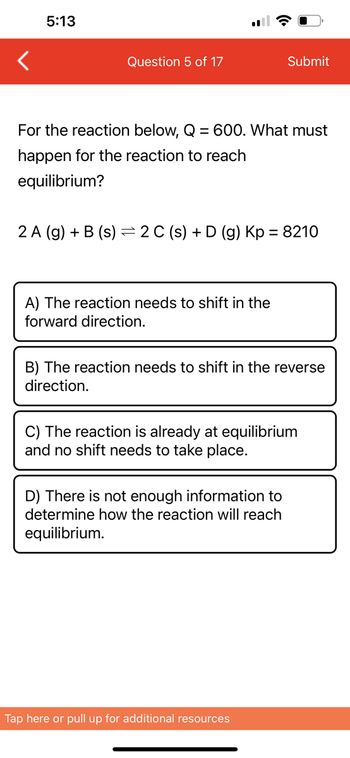
Chemistry
10th Edition
ISBN: 9781305957404
Author: Steven S. Zumdahl, Susan A. Zumdahl, Donald J. DeCoste
Publisher: Cengage Learning
expand_more
expand_more
format_list_bulleted
Question

Transcribed Image Text:5:13
Question 5 of 17
For the reaction below, Q = 600. What must
happen for the reaction to reach
equilibrium?
2 A (g) + B (s) 2 C (s) + D (g) Kp = 8210
A) The reaction needs to shift in the
forward direction.
Submit
B) The reaction needs to shift in the reverse
direction.
C) The reaction is already at equilibrium
and no shift needs to take place.
D) There is not enough information to
determine how the reaction will reach
equilibrium.
Tap here or pull up for additional resources
Expert Solution
This question has been solved!
Explore an expertly crafted, step-by-step solution for a thorough understanding of key concepts.
This is a popular solution
Trending nowThis is a popular solution!
Step by stepSolved in 2 steps with 2 images

Knowledge Booster
Learn more about
Need a deep-dive on the concept behind this application? Look no further. Learn more about this topic, chemistry and related others by exploring similar questions and additional content below.Similar questions
- An empty steel container is filled with 0.0490 atm of HF. The system is allowed to reach equilibrium. If Kp = 2.76 for the reaction below, what is the equilibrium partial pressure of H₂? 2 2 HF (g) → H2 (g) + F2 (g)arrow_forwardEXPLAIN STEP BY STEParrow_forwardA reaction vessel initially contains 3.00 atm of SO2 and 1.00 atm of O2. A reaction occurs according to the equation: 2 SO2(g)+ O2(g) ⇄ 2 SO3(g)When equilibrium is reached, the total pressure is found to be 3.75 atm. What is the equilibrium constant Kp?arrow_forward
- 10) For the reaction: 2 V PC13(g) + Cl2(g) → PC15(g) at 85°C, Kp = 1.19 = If one starts with 2.00 atm pressure of PC13, 1.00 atm pressure of Cl2 and no PC15, what is the partial pressure of PC15(g) at equilibrium? A) 0.739 atm B) 0.621 atm C) 0.465 atm D) 0.167 atm E) 0.553 atmarrow_forwardAt 1000 K, a sample of pure NO₂ gas decomposes: 2 2NO₂(g) = 2NO(g) + O₂(g) The equilibrium constant Kp, is 158. Analysis shows that the partial pressure of O₂ is 0.41 atm at equilibrium. Part 1 of 2 What is the pressure of NO? Be sure your answer has the correct number of significant digits. Part 2 of 2 atm x10 atm X What is the pressure of NO₂? Be sure your answer has the correct number of significant digits. Ś x10arrow_forwardAn empty steel container is filled with 0.840 atm of A and 0.840 atm of B. The system is allowed to reach equilibrium according to the reaction below. If Kp = 340 for this reaction, what is the equilibrium partial pressure of C? A (g) + B (g) = C (g)arrow_forward
- At a particular temperature, the reaction below has a K value of 1.03 x 10-2. If [SO3] = 0.97M, [SO2] = 1.4 x 10-1M, and [O2] = 0.83M, determine if the reaction is at equilibrium, needs to shift right to reach equilibrium, or if it needs to shift left to reach equilibrium. 2 SO3(g) <---> 2 SO2(g) + O2(g) a. Q less than K, shift right b. Q greater than K, shift left c. Q less than K, shift left d. Q greater than K, shift right e. at equilibriumarrow_forward4. IBr decomposes according to the reaction at 150 C: 2 IB (g) = 12 (g) + Brz (g) If IBr is placed in a container at an initial pressure of 5.0 atm, what will be its equilibrium pressure at 150°C? K = 8.3 x 10-3arrow_forwardConsider the reaction. 2 A(g) = B(g) Kp = 5.62 x 10-5 at 500 K If a sample of A(g) at 4.20 atm is heated to 500 K, what is the pressure of B(g) at equilibrium? PB = atmarrow_forward
- Consider the following reaction: CO2(g) + C(graphite) = 2 CO(g) A reaction mixture initially contains 0.56 atm CO2 and 0.32 atm CO. If the equilibrium pressure of CO gas is 0.83 atm, find the equilibrium constant (Kp) for the reaction.arrow_forwardCan you provide an explanation? And show the stepsarrow_forwardConsider the following exothermic reaction, used to obtain lead from its ore:2PbS (s) + 3O2 (g) + 2CO (g) ↔ 2 Pb (l) + 2SO2 (g) + 2CO2 (g)Assume that this reaction is in equilibrium. Given the following changes to the system, will the quantity of lead increase, decrease, or remain the same?i) adding more lead sulfide.ii) Adding more carbon monoxide.iii) removing some oxygen.arrow_forward
arrow_back_ios
arrow_forward_ios
Recommended textbooks for you
 ChemistryChemistryISBN:9781305957404Author:Steven S. Zumdahl, Susan A. Zumdahl, Donald J. DeCostePublisher:Cengage Learning
ChemistryChemistryISBN:9781305957404Author:Steven S. Zumdahl, Susan A. Zumdahl, Donald J. DeCostePublisher:Cengage Learning ChemistryChemistryISBN:9781259911156Author:Raymond Chang Dr., Jason Overby ProfessorPublisher:McGraw-Hill Education
ChemistryChemistryISBN:9781259911156Author:Raymond Chang Dr., Jason Overby ProfessorPublisher:McGraw-Hill Education Principles of Instrumental AnalysisChemistryISBN:9781305577213Author:Douglas A. Skoog, F. James Holler, Stanley R. CrouchPublisher:Cengage Learning
Principles of Instrumental AnalysisChemistryISBN:9781305577213Author:Douglas A. Skoog, F. James Holler, Stanley R. CrouchPublisher:Cengage Learning Organic ChemistryChemistryISBN:9780078021558Author:Janice Gorzynski Smith Dr.Publisher:McGraw-Hill Education
Organic ChemistryChemistryISBN:9780078021558Author:Janice Gorzynski Smith Dr.Publisher:McGraw-Hill Education Chemistry: Principles and ReactionsChemistryISBN:9781305079373Author:William L. Masterton, Cecile N. HurleyPublisher:Cengage Learning
Chemistry: Principles and ReactionsChemistryISBN:9781305079373Author:William L. Masterton, Cecile N. HurleyPublisher:Cengage Learning Elementary Principles of Chemical Processes, Bind...ChemistryISBN:9781118431221Author:Richard M. Felder, Ronald W. Rousseau, Lisa G. BullardPublisher:WILEY
Elementary Principles of Chemical Processes, Bind...ChemistryISBN:9781118431221Author:Richard M. Felder, Ronald W. Rousseau, Lisa G. BullardPublisher:WILEY

Chemistry
Chemistry
ISBN:9781305957404
Author:Steven S. Zumdahl, Susan A. Zumdahl, Donald J. DeCoste
Publisher:Cengage Learning

Chemistry
Chemistry
ISBN:9781259911156
Author:Raymond Chang Dr., Jason Overby Professor
Publisher:McGraw-Hill Education

Principles of Instrumental Analysis
Chemistry
ISBN:9781305577213
Author:Douglas A. Skoog, F. James Holler, Stanley R. Crouch
Publisher:Cengage Learning

Organic Chemistry
Chemistry
ISBN:9780078021558
Author:Janice Gorzynski Smith Dr.
Publisher:McGraw-Hill Education

Chemistry: Principles and Reactions
Chemistry
ISBN:9781305079373
Author:William L. Masterton, Cecile N. Hurley
Publisher:Cengage Learning

Elementary Principles of Chemical Processes, Bind...
Chemistry
ISBN:9781118431221
Author:Richard M. Felder, Ronald W. Rousseau, Lisa G. Bullard
Publisher:WILEY